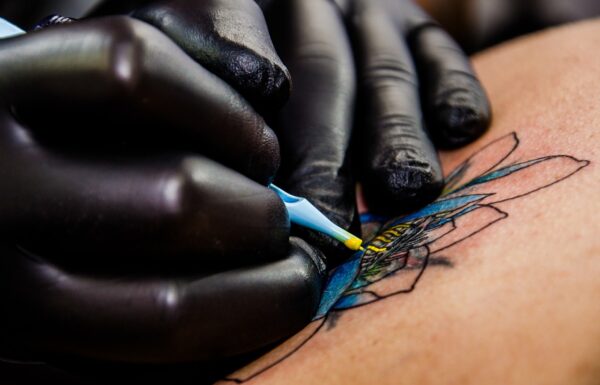I got my first tattoo when I was fifteen. While this probably wasn’t the most sensible choice I (or my mother) ever made, all the tattoos I’ve gotten since then (about ten or so) have peeled within a week of getting them. While it can be itchy and uncomfortable, it’s all part of the healing process. While it may look like the ink is coming out of your tattoo, the peeling process is entirely normal and indicates a properly healing tattoo. If you’re worried about fading, read on to find out just what happens during the peeling process.
Table of Contents
Do Tattoos Fade When They Peel?
When your tattoo begins to peel during the healing process, it shouldn’t fade or lose color significantly.
While there are many different reasons for a tattoo fading over time, the peeling process is rarely one of them. Because it’s a wound, the peeling process is part of the healing process and should begin in the first week after getting your tattoo.
With the fact that peeling is normal in mind, let’s take a look at some of the other reasons why a tattoo may fade or peel. By the end of this article, you’ll have nothing to fear when it comes to your tattoos…except the pain, of course!
So Why Do Tattoos Peel In The First Place?
When you get a new tattoo, you should treat it just as carefully as you would treat any other trauma to your body, no matter how minor. A tattoo is basically a wound. During the tattoo process, the tattooing needle can penetrate your skin thousands of times. The peeling is a response to the trauma of that wound.
When your tattoo peels, it is your body’s response of shedding the outer layer of skin on what it thinks is a wound so that it can begin the healing process. Tattoo ink resides in the dermis, or middle layer, of your skin. What you see peeling away from your skin is the epidermis exfoliating old skin cells to heal itself.
How Long Does The Peeling Stage Last?
The simple answer to this question is anywhere from a few days to one month. Every person’s body is different. Therefore, the healing process will be different depending on who you ask. There are several reasons why peeling may differ between people. Everything from tattoo location, size, the color saturation of the ink, and the type of colors used can affect how long the peeling stage will last.
On average, most people will begin experiencing the peeling stage around day 4 or 5 after getting a tattoo, though you can experience it earlier. Once the peeling starts, it will typically last for 1-2 weeks.
Other contributing factors to how long peeling lasts include aftercare, such as the products you use to keep your skin moisturized while it’s healing. Keep on reading to find out more details on how to take care of your peeling tattoo!
Does Ink Come Out When A Tattoo Peels?
As we mentioned earlier, the ink in your tattoo resides in the dermis or the middle layer of your skin. The skin that peels during the healing process is in the outer layer. So while it may look like there are bits of ink in the skin you’re shedding, you don’t have to worry about fading in your tattoo unless there are other fading or color loss symptoms. In fact, after your tattoo peels, you may find the colors even more vibrant, as you have now shed the outer layers of the epidermis.
How To Take Care of Your Peeling Tattoo
You should follow these steps in the aftercare process while taking care of your tattoo to ensure that it heals entirely and safely. To help your tattoo before, after, and during the peeling stages, you should practice the following:
After removing any bandages from the tattoo parlor (I find the easiest way to do this is in the shower, which helps remove the bandage without tugging too harshly at the skin), you should gently cleanse your tattoo with plain soap and water.
The next important step is to keep your skin moisturized while it’s healing. You can use several different products, but I prefer a plain, unscented lotion. Or, if it has a scent, make sure it’s a natural one, such as pure cocoa butter. Anything with added chemicals or perfumes (this goes for soap as well) can cause irritations to your skin while it’s healing.
Wear loose clothing, and do not pick at the peeling skin. Picking at the peeling skin is one of the things that can lead to a color loss where you wouldn’t usually have it. Once your tattoo begins peeling, you will most likely experience some itching, but be sure not to scratch! If your tattoo is incredibly itchy, try blowing on it to ease the sensation.
Other activities to avoid include exposing your tattoo to direct sunlight or swimming in a pool. Showers are perfectly safe, though!
If It’s Not From Peeling, Why Did My Tattoo Fade?
If they aren’t fading due to the peeling process, why might a tattoo fade? There are a few contributing factors to tattoo fading.
Improper aftercare is one of the most significant, so be sure to follow your tattoo artist’s instructions to the letter.
Sun exposure is another contributor to fading. If you get tattooed in the middle of the summer, you may be tempted to show off your new ink on the beach as soon as possible. But it’s better to get tattooed in the winter when it’s easier to avoid direct sunlight. Don’t attempt to rely on SPF either – it can irritate a healing tattoo. If you get tattooed in the winter, by the summer months, your tattoo should be beautifully healed and ready to shine!
An inexperienced artist can also contribute to tattoo fading. An inexperienced artist may deposit the ink into the epidermis of your skin, resulting in the shedding and regenerating of your skin cells, which will cause fading.
Product quality in terms of ink can also affect your color. Before you book your appointment, you should chat with the parlor staff about what kind and quality of inks they use.
Then there is placement. If you get a tattoo on a part of your body that experiences a lot of friction, it is more likely to fade. Areas that regenerate skin more frequently, such as your feet and hands, are more susceptible to fading.
It’s also important to remember that no tattoo is ageless. As you age, your skin will change. This can cause fading, depending on how you treat your skin. Keeping up a good moisturizing routine, as well as preventing sun damage with SPF, are two of the best practices for protecting your skin and tattoos as they age.
What If My Tattoo Doesn’t Peel?
If you don’t notice peeling in your new tattoo, don’t panic. While most tattoos will go through a peeling process, your skin may heal differently. The peeling could be minuscule enough that you won’t notice any large scabs or flakes. Even if you don’t see the peeling process, you should continue to wash and moisturize your tattoo as usual.
What you shouldn’t do is try to induce the peeling process. Scratching in any way at your healing tattoo could cause complications such as infection or scarring.
Do Old Tattoos Peel?
If you’re an old pro at tattoos and suddenly find one of your long healed tattoos peeling again, this may be cause for concern. If you find that one of your older tattoos is suddenly peeling again, you may want to book an appointment with your dermatologist. Sudden peeling in a healed tattoo can indicate an allergic reaction to your tattoo ink.
What Can I Do If My Tattoo Fades?
Unfortunately, when it comes to tattoos, there is only one way to rejuvenate your faded ink. You can return to your artist, or another artist, for a touch-up. Your artist will go over the faded areas with new ink during a touch-up and accentuate the faded regions to give your tattoo new life.
You can also opt to get a cover-up. A cover-up is when you tattoo a new design over your old one. Depending on your original tattoo, it may be very easy or very complicated to do a cover-up.
At the end of the day, the peeling process is a normal and expected part of the healing process. If you put thought and care into the tattoo process and your aftercare, your tattoo should not fade once it is healed.

